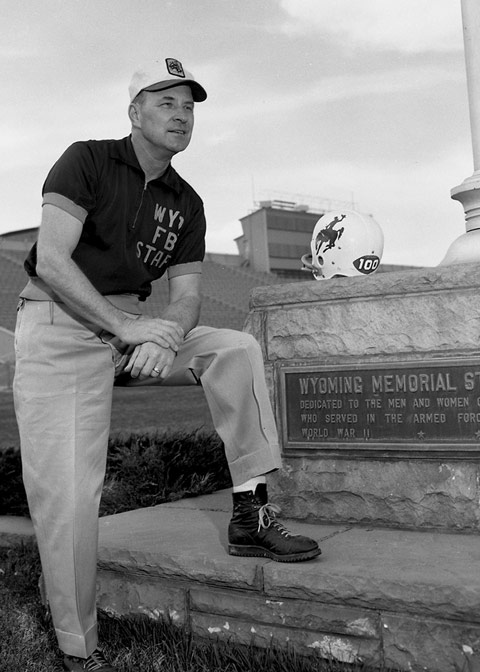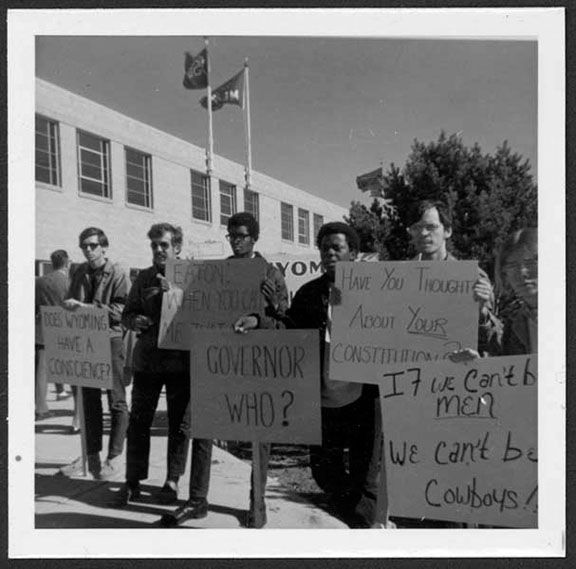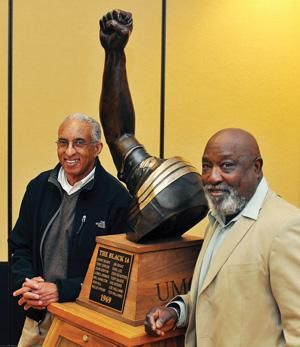

Eaton would later testify in federal court that he “told them that if the program at Wyoming was not satisfactory then perhaps they had better think about going to Morgan State or Grambling”—both traditional black colleges.
The players emptied their lockers and walked to the student union. They asked UW President William Carlson to arrange a meeting with Eaton at Old Main. In the afternoon, the players met with Carlson, Athletic Director Red Jacoby and student leaders, but Eaton did not appear.
That evening, the coaches and players met separately with the UW Board of Trustees and Wyoming Governor Stanley K. Hathaway during a special meeting lasting from 8 p.m. to 3:15 a.m. Saturday. At that late hour, the university issued a press release saying the trustees confirmed the dismissal of the 14 players. The players “will not play in today’s game or any during the balance of the season,” the press release noted, and added: “The dismissals result from a violation of a football coaching rule Friday morning.”
Athletic Director Jacoby further noted in the release that “(a)mple notice was given to all members of the football team regarding rules and regulations of the squad, some of which cover a ban on participation in student demonstrations of any kind. Our football coaching staff has made it perfectly clear to all members of the team that groups, or factions, will not be tolerated and that team members will be treated as individuals.”
According to Jacoby, the staff had “no recourse” when the 14 players appeared as a group at the coach’s office. “We had no choice but to drop them from the squad. It is unfortunate this happened, but an open defiance of a coaching staff regulation cannot be tolerated.”
On Saturday, the Cowboys, suddenly an all-white team, defeated all-white BYU 40-7 while the 14 dismissed black players watched from the student section of the stands. Fans on both sides of the stadium chanted, “We love Eaton.” After the game, Eaton said, “The victory was the most satisfying one I’ve ever had in coaching.”
[…]
Statistics published in the program for the game showed that the 14 African-American players had contributed substantially that year to the team’s unbeaten status through the first four games. John Griffin, a junior college transfer from San Fernando, Calif., was the leading receiver; Ron Hill of Denver led in kickoff returns; and Joe Williams of Lufkin, Texas, and Tony Gibson were third and fourth, respectively, in rushing. Ted Williams, another transfer from Port Hueneme, Calif., relieved the injured Joe Williams (no relation) in the CSU game and rushed for 87 years to lead the Cowboys’ ground attack.
Mel Hamilton, a junior and a former mayor of Boys Town, Neb., had moved into a starting position in the offensive line, and Gibson, a junior from Pittsfield, Mass., started at fullback in the UTEP game. Ivie Moore, a Pine Bluff, Ark., defensive back who transferred from a Kansas junior college, was listed as a starter for the BYU game.
Defensive end Tony McGee, a junior from Battle Creek, Mich., had keyed the Cowboys’ thrilling come-from-behind win at the Air Force Academy by tackling the AFA quarterback for losses seven times.
Only one of the 14 was a senior at the time of their dismissal. Two—Mel Hamilton and Earl Lee—had already served in the U.S. Army. Half of them were under 21 years old.
The national spotlight

The dismissal of the 14 brought camera crews from the three big TV networks to Laramie, and articles appeared in newspapers and magazines throughout the nation. The Nov. 3, 1969, issue of Sports Illustrated carried an article whose photographs included one showing 10 of the dismissed players sitting on the south steps of the Wyoming Union. The Casper, Wyo. Quarterback Club, the Rock Springs Wyo. City Council and the University of Wyoming Alumni Association supported the coach.
Aside from some of the students, the Denver Post and the student newspaper at UW, one of the few expressions of concern for the dismissed players, ironically enough, was an unnamed source close to the BYU Board of Trustees quoted in the Oct. 24, 1969, issue of the Denver Post.
“It’s most disturbing,” said the source, “to think that the Negro athletes at Wyoming could lose their education.”
[…]
The events had a devastating effect on Wyoming football. After six games, UW was still unbeaten and still rated among the top 15 in the national polls. Many fans were convinced the Cowboys could continue their winning ways without any African-American players.
But protests against Eaton’s actions followed the Cowboys on the road, and they lost the last four games of the 1969 season by lopsided scores.
The 1970 team lost all of its home games and all but the CSU game on the road, finishing with one win and nine losses–the worst record since the no-wins one-tie season in 1939, and the first time UW lost all its home games since 1931. It was the Cowboys’ first losing season since 1948. And future prospects looked dim because the 1970 freshman team had a winless season. Support for Eaton evaporated.
During the first week after the 1970 season ended, Wyoming sports pages included columns quoting Eaton on his plans to step up recruiting across the country, particularly from the junior college ranks. But on Dec. 6, 1970, Lloyd Eaton’s coaching career came to an abrupt end.
In a press conference after their meeting, the UW Board of Trustees announced that Eaton was “retiring” from active coaching and would become an assistant athletic director whose duties were still undetermined. Eaton said the decision to retire had been made two years earlier, after the Sugar Bowl game. Defensive line coach Leonard F. (Fritz) Shurmur, 38, was appointed to replace Eaton. In 1971 Eaton left UW and held administrative and scouting positions in pro football, including a stint as Director of Player Personnel for the Green Bay Packers.
But the negative publicity affected Wyoming’s football program for years. Following the dismissal of the 14, the Cowboys lost 26 of their next 38 games through 1972. They had only one winning season during the 1970s. Paul Roach, one of Eaton’s assistant coaches in 1969 returned to Wyoming as athletic director in the mid-1980s, and in 1987 also took on the head football coaching duties. His 1987 and 1988 teams went 21-5 and played in the Holiday Bowl both years.
[…]
The players in later life

Tony McGee became a dominant player in the NFL, starting in a Super Bowl for the Redskins. For many years McGee has hosted a sports television talk show in Washington D.C. Joe Williams also earned a Super Bowl ring with the Dallas Cowboys and then developed his own investment consulting business.
Several of the Black 14 managed to obtain college degrees. Mel Hamilton graduated from UW and has had a long career as a public school teacher and administrator in Casper. Guillermo Hysaw, originally from Bakersfield, Calif., and Lionel Grimes from Alliance, Ohio, became employment diversity executives with Ford and Toyota. Jay Berry—“Jerry Berry”–became a sports anchor for television stations in Tulsa, Chicago and Detroit and was named by Associated Press as the top sports broadcaster in Texas in 1977
Tony Gibson retired in 2011 after working nearly 38 years as a lineman for a Massachusetts power company during which time he responded to mass outages in Puerto Rico, Canada, Florida and several other states. Ted Williams has worked that long as a foreman at a specialized paint manufacturing company in Illinois. Ron Hill became a physical education teacher in Colorado. John Griffin has worked for the YMCA in Denver, for a hazardous waste abatement firm and as a manager for Sports Authority in Denver. Ivie Moore has worked as a floor subcontractor in his native Arkansas.
James Isaac died in San Bernardino, Calif. in 1976 after a dispute with his wife; Don Meadows died in 2009 and Earl Lee in 2013. Lee had a distinguished career as a teacher, coach and principal in the Baltimore area. Isaac, an all-sports star for Hanna-Elk Mountain High School in Wyoming, played football and ran track for, and graduated from, Dakota Wesleyan University in South Dakota. Don Meadows had a restaurant business in Denver.
In the records section of the 2013 University of Wyoming Cowboys’ Football Media Guide, the name Jerry Berry appears with two other players who are tied for most interceptions returned for touchdowns in a season, and with three others for most returns for touchdowns in a career.
Berry’s entire career at UW consisted of the first four games of the 1969 season. After his 88-yard return against Arizona he carried another interception 24 yards for a touchdown in the CSU game two weeks later.

